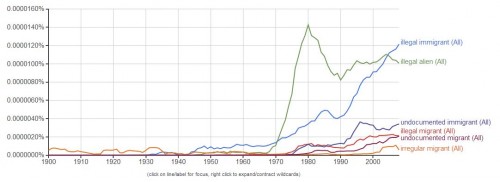Citing the immigration scholar, Francesca Pizzutelli, Fabio Rojas explains that the phrase “illegal immigrant” wasn’t a part of the English language before the 1930s. More often, people used the phrase “irregular immigrant.” Instead of an evaluative term, it was a descriptive one referring to people who moved around and often crossed borders for work.
Rojas points out that the language began to change after anti-immigration laws were passed by Congress in the 1920s. The graph above also reveals a steep climb in both “illegal immigrant” and “illegal alien” beginning in the ’70s.
Lisa Wade, PhD is an Associate Professor at Tulane University. She is the author of American Hookup, a book about college sexual culture; a textbook about gender; and a forthcoming introductory text: Terrible Magnificent Sociology. You can follow her on Twitter and Instagram.

Comments 5
Bill R — August 16, 2014
When a descriptive term was used people probably didn't perceive it as a real problem.
I would assume that as immigration was perceived as problematic by a larger percentage of the population there would be calls for greater enforcement of laws limiting immigrants and that terms such as "illegal immigrant" or "illegal alien" would logically be used in that context.
No?
Larry Charles Wilson — August 16, 2014
In the late 19th and early 20th centuries a lot of Eastern Jews entered the United States by way of Canada; having first passed through the UK.
TelmeaStory — August 26, 2014
Wasn't part of the English language as represented in the books scanned by Google and available to the NGram Viewer.
Zain Daudpoto — August 26, 2014
In Sindh province of Pakistan Mohajir (Immigrants) call themselves "Mohajir Nation". These Muslim peoples were migrated from various parts of India to Sindh as province of Pakistan after Division of India in 1947.